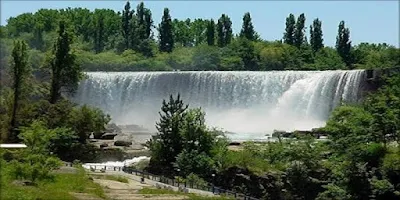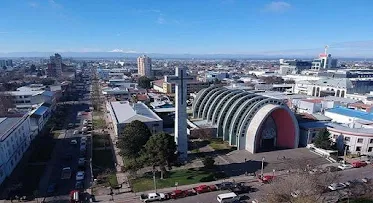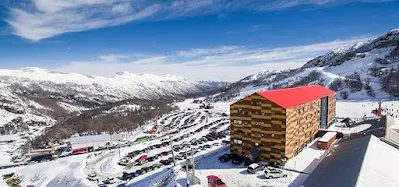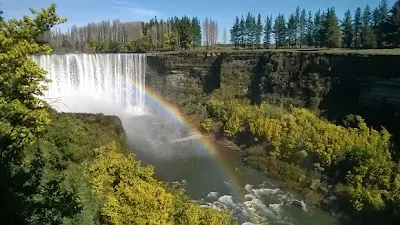- Get link
- Other Apps
 |
| Image: Raphael Sierra P. - Diario Concepción |
The Bio Bio Region, often referred to by its ancient name of "Octava Region" (Eighth Region of Chile), has an area of 23,890 km² and a population of just over 2,100,000 people, its name comes from the river that crosses the region. The regional capital is Concepcion, the largest city in Southern Chile and the second largest in the country. The population of Greater Concepcion, including Talcahuano and other adjacent municipalities, reaches nearly one million inhabitants.
Bio Bio is an industrial region, especially as it relates to forestry and derivatives, agribusiness, iron and steel production, oil refinery, small-scale fishing, tourism industry. The educational sector also has a good level of development, since in Concepcion are concentrated many professional institutes and universities, either private or state supported, of great importance nationwide. In addition, this region, located on average about 500 km. South of Santiago, is also rich in natural beauty and attractions.
Important: In September 2018 was created the new region of Ñuble, which until then was part of Bio Bio. Its population is 480,000 inhabitants and its capital is the city of Chillan. Here is a list of places to visit in Bio Bio and Ñuble regions.
Cathedral of Concepcion
.webp) |
| Image: minube.com |
Right in front of the Plaza de la Independencia, the historical and cultural heart of the city. Built between 1940 and 1950, it was officially inaugurated in 1964, replacing the original building, which was destroyed by a great earthquake in 1939, known as the "Chillan earthquake", which left 30,000 dead.
Inside the temple is the Museo de Arte Sagrado (Museum of Sacred Art), an artistic and historical collection. The Catholic Sanctuary is both a place of worship and a tourist attraction.
Ironclad Huascar
Historic nineteenth-century battleship, currently restored and converted into a floating museum, anchored in the port of Talcahuano, Chile's main naval base. More than once, this true relic has caused controversy between Chile and Peru. Built by British shipyards in 1863, the Monitor Huascar was the flagship of the Peruvian Navy during the War of the Pacific. After the naval battle of Iquique, where the Huascar encountered and sank the Chilean corvette Esmeralda, it was captured by Chile in the Battle of Angamos on October 8, 1879. In this battle died the Peruvian Admiral Miguel Grau, the greatest Peruvian naval hero.
The Huascar, one of the oldest floating museums in the world, is more than a trophy of war, it is a symbol of brotherhood, defined by the Chilean Navy as "the floating shrine of the naval glory of Chile and Peru". After suffering the ravages of the tsunami that hit Chile on February 27, 2010, which moved the ship about 30 meters from its original position, the Monitor Huáscar was soon returned to its anchorage in the port of Talcahuano, one of the hardest hit by the waves. In 1995, the World Ship Trust awarded the Chilean Navy the Maritime Heritage Award for the excellent restoration of the Huascar and the invaluable historical testimony that this work represents for Chile and Peru.
Visiting hours: Tuesday to Sunday from 9:30 to 12:30 hrs. and from 13:30 to 19:30 hrs.
Museums in Concepcion
Museo de Historia Natural, Address: 2359 Maipu St., Plaza Acevedo. Founded in 1902 by the British naturalist Edwin Reed Brookman, this small gallery shows part of the geographical history of the Bio Bio region, Chile and South America. The permanent exhibition is divided into several sections, such as: Los Coleccionistas; Espacio Regional; El Mundo de los Fósiles, with specimens from about 65 million years ago; Presencia del Carbón: the geological history of this mineral and what it has meant to the region in human and economic terms; Objects from the Mapuche and Selknam ancestral cultures.
Casa del Arte, art gallery located on the campus of the University of Concepcion, in front of Plaza Peru, city of Concepcion. The largest collection of Chilean paintings in the country, with more than 2,500 works, covering almost all periods. At the entrance is the mural Presencia de America Latina, painted in 1964 by the Mexican muralist Jorge González Camarena.
Galeria de la Historia, Address: Parque Ecuador, on the slopes of Cerro Caracol. This illustrative exhibition shows different historical aspects of Concepcion through miniatures, along with audio and legends that enliven the tour. It also includes exhibitions of handicrafts, silverware, instruments, clothing and utensils of the indigenous Mapuche culture. You can also see the collection of the best pieces of regional ceramics, donated by Gloria Herrera. The regional ceramic industry had a great apogee during the 20th century.
Museo de Arte Religioso, Religious Art Museum next to the city's cathedral. Founded in 1995, it contains about 600 pieces of history, art and religious tradition of the city and the archdiocese. You can see ancient liturgical vestments, Bibles from different periods and languages, precious objects such as an ivory Christ with silver inlays donated to the Old Cathedral by King Felipe II, paintings, photographs, books, furniture and memorabilia from Pope John Paul II's visit to the city in 1987.
Museo Geologico Profesor Lajos Biro Bagoczky, Geological Museum of the University of Concepcion. The gallery displays more than 30,000 pieces of minerals, petrified trunks, fossils and rocks, some of which are millions of years old. Online Tour Here.
Port City of Talcahuano
Founded in 1764, the port of Talcahuano, with a population of approximately 160,000, is a historic city strategically located on the bay of the same name, approximately 10 km north of Concepción, Chile's second largest city. Talcahuano suffered significant damage during the 2010 earthquake and tsunami, but has shown great resilience and determination to rebuild.
The city stands out as one of the most important port and maritime centers of the country, which includes the development of the Chilean Navy and its participation in important naval events.
The Port of Talcahuano offers a wide variety of tourist attractions, including its beautiful bay, maritime heritage, and delicious seafood gastronomy. Some other tourist attractions include the Marina del Sol Casino, a popular entertainment destination with games, restaurants and shows, Caleta Tumbes (Tumbes Cove), the Artisanal Fishing Terminal, the La Tortuga Municipal Coliseum, the Naval Museum and the Compañía de Acero del Pacífico Stadium.
Talcahuano is also an important commercial and manufacturing center, with industries such as fishing, flour milling, oil refining, steel production, shipyards and all activities related to the sea, which have contributed to its economic vitality.
Visitors can enjoy beautiful maritime landscapes, nearby beaches and a varied gastronomic offer based on fresh seafood. The Port of Talcahuano is one of the most important in Chile, which makes it an interesting place to learn about the dynamics of the port and maritime activities.
The city's historical heritage is reflected in its old buildings, such as the church of San Francisco, which dates from the 18th century. In addition, the Huáscar Museum presents the history of the Chilean Navy and its role in the War of the Pacific.
Talcahuano is also known for its welcoming atmosphere and the warmth of its people. Its strategic location and maritime importance make it an interesting destination for those who want to explore the cultural and historical richness of Chile, as well as enjoy the natural beauty of the region.
Isla Mocha (Mocha Island)
Located 35 km. from the coast on the border of the regions of Biobio and La Araucania. Discovered in 1550, it has 14 km. long and an average of 6 km. wide, its central part covered by a lush forest. The island was a refuge for English and Dutch corsairs such as Sir Francis Drake, Olivier van Noort and Joris van Spilbergen. Many ships have sunk around its shores in ancient times, some of them laden with treasures.
Its main attraction is the Reserva Nacional Isla Mocha, managed by CONAF (National Forest Corporation). The main tourist activities are guided trekking tours of varying difficulty, horseback riding, horse-drawn carriage rides, mountain biking, scuba diving, exploring the shipwrecks around the island, bird-watching, and observing the abundant marine life, especially the spectacular colonies of sea lions. You can also enjoy water sports such as windsurfing and sport fishing.
Salto del Laja (Laja River Falls)
 |
| Salto del Laja Falls |
Balneario de Dichato (Dichato Beach)
Small town of just over 3,000 inhabitants located in the commune of Tomé, 37 km. N. of Concepcion, whose infrastructure was badly damaged by the tsunami of February 27, 2010, Today it has resumed its normal life and the authorities have placed special emphasis on recovering the tourist flow the town always had. The bay of Dichato has a half-moon shape, being a very closed bay with calm waters, suitable for water sports and very popular in summer. During the summer there is a wide range of entertainment, including a major music festival, while the gentle surf of its sheltered bay allows the safe practice of all kinds of water sports. The offer of hotels and services is wide and available all year round.
San Pedro de La Paz
Municipality with great tourist potential based on ecotourism, with lagoons suitable for sports tourism, gastronomic offer, bird watching, hiking, religious tourism, etc. It is located southwest of the Bio Bio River and has a population of about 150,000 inhabitants. Among its attractions stand out the Puente Ferroviario (Railroad Bridge), built in 1889 to connect the city of Concepción with the coal mines of Lota and the port of Coronel; Laguna Grande, a small lake of glacial origin, of shallow depth. Not suitable for swimming, but where you can practice water sports such as sailing, rowing and kayaking, members of the local rowing club have achieved important triumphs even internationally; Laguna Chica, around this lagoon there are beaches such as the Balneario Municipal, sports centers of both public and private character and nautical clubs; Amphitheater of San Pedro de la Paz, next to the Cultural Center, in a privileged setting where live shows are performed; Mouth of the Bio Bio River, the largest watercourse in the region and the second longest in Chile.Laguna Llacolén
With its serene atmosphere and abundant wildlife, Laguna Llacolén is a must-see destination for nature lovers and outdoor enthusiasts visiting Concepción. Llacolén, or Laguna Chica, is a picturesque freshwater lagoon in Concepción, nestled amidst lush greenery and surrounded by rolling hills, this natural gem offers a tranquil escape from the hustle and bustle of city life.
Visitors can enjoy various recreational activities such as boating, kayaking and fishing in the crystal clear waters of the lagoon. The scenic trails around the lagoon offer breathtaking views and are perfect for leisurely strolls or picnics. It should be noted that Laguna Llacolén was the site of many of the nautical competitions of the 2023 Pan American Games held in Chile.
City of Chillan
 |
| A view of Chillan, capital of Ñuble Region Image: nuevopoder.cl |
Chillan, located 403 km. South of Santiago, it is the capital of the Ñuble Region. Its population is close to 200,000 inhabitants. The city, birthplace of the Father of the Nation Bernardo O'Higgins, is a strategic point to start a journey through many tourist attractions in the south of Chile.
But the city and its surroundings have their own interesting sites for the visitor, such as the Cathedral, the main postcard of the city, located next to the main square, built after the violent earthquake of 1939. With arches of more than 20 meters and a monumental cross 39 meters high.
The Claudio Arrau Museum, address: 558, Claudio Arrau st., a cultural site dedicated to the life and work of the famous pianist Claudio Arrau Leon, a native of this city and considered one of the most important pianists of the 20th century.
Another museum to visit is located at 720 Andres Bello Ave., in the premises of the Bio Bio University. This is the Marta Colvin Museum, which was awarded the National Prize of Art in 1970 and also a native of this city. By appointment, the museum offers a library and guided visits for schools and cultural groups.
The Museo Internacional de la Grafica, located on the corner of O'Higgins Ave. and Vegas de Saldia, is a gallery dedicated to the preservation and dissemination of national and international graphic art. Founded in 1997 by the artist Hernando León, it is the only museum in Chile dedicated to graphic art and has a collection of 450 works by European and Latin American authors from the second half of the 20th century.
The Mercado de Chillan, address: 773, Maipon St., is a must for any tourist, wide, varied, safe and clean place, in the center of the city, where you can find a great variety of vegetables, fruits, fish, seafood and the famous Longaniza de Chillan, (spicy, long pork sausage), an appetizing and characteristic product of this part of Chile. Crossing a narrow street, we visit the Feria Artesanal de Chillan or Feria de la Plaza Sargento Aldea, with thousands of typical products of the Chilean countryside, from this region and from other parts of the country. It is the right place to choose a souvenir, either in wicker, wood, leather, ceramics, warm handmade ponchos and much more.
Nevados de Chillan
 |
| Hotel Alto Nevados |
There are daily fun activities for all ages and relaxation in summer and especially in winter when its ski slopes, considered among the best in South America, are in operation. This mountain resort, which will soon be one of the largest in South America, currently consists of 2 hotels: Hotel Nevados and Hotel Alto Nevados, the latter in the middle of the Nevados de Chillan Ski Center. There are two winter sports centers, Nevados and Valle Hermoso, 11 ski lifts, 6 cafeterias, 3 spas, a large bike park and 8 pools with thermal water in different locations.
Salto del Itata
 |
| Itata River Falls |
City of Los Angeles
Los Angeles is a city known for its rich history, natural beauty, colonial architecture and pleasant climate. For tourists, there are many things to do and see in Los Angeles.
With a population of just over 220,000, it is located 510 kilometers south of Santiago, the country's capital, and 127 kilometers northeast of Concepción, the regional capital.
One of the most popular attractions is the Laguna del Laja National Park. This park features an impressive waterfall, hiking trails and beautiful natural scenery. There is also a wide variety of birds and animals to observe.
Tourists interested in history and culture can visit the Municipal Historical Museum, which displays artifacts and exhibits related to local history. In addition, the city's representative architecture, including the Cathedral of Los Angeles and other historic buildings, gives visitors the opportunity to immerse themselves in the region's cultural heritage.
Another popular attraction is the Museo de la Alta Frontera. This museum tells the history of the region and its importance in the fight for Chilean independence. There are also many artifacts and historical objects on display.
For those interested in local culture, the Municipal Market is a place not to be missed. Here you can find local products such as fruits, vegetables and handicrafts. There is also a wide variety of restaurants offering typical dishes of the region. The gastronomic offer is remarkable, with a variety of traditional Chilean dishes available in the city's restaurants. Tourists can try delicacies such as pastel de choclo (corn pie), empanadas and fresh seafood. As for nightlife, Los Angeles has a large number of bars and nightclubs.
Parque Nacional Laguna del Laja
Laguna del Laja National Park, of 11,600 hectares, is located in the Andean foothills of the Biobio region, in the municipality of Antuco, 93 Km. from the city of Los Angeles and very close to the border with Argentina. The nature of southern Chile is wonderful and this park is no exception, inside there are several trails you can walk to enjoy the scenery. The main activities are sport fishing, climbing, trekking, wildlife observation. Within its boundaries lies the Laguna del Laja, the largest natural dam in the country, formed thousands of years ago by the eruption of the neighboring Antuco volcano, another attraction of the park. The Antuco volcano is about 10,000 years old and is one of the most famous volcanoes in Chile. At the foot of the volcano is the memorial with the names of the 45 Chilean army conscripts who died as a result of a blizzard in May 2005 during a military exercise. Nearby is the Sierra Velluda stratovolcano, a lesser known name but even more imposing than the Antuco volcano, this mountain has two main peaks, whose northern peak, at 3,585 meters, is the highest mountain in the region.
Another attraction of this national park is the Rio Laja, which rises in the lake of the same name and, after traveling 148 kilometers westward, gives rise to the famous Salto del Rio Laja. Near the Laguna del Laja National Park, 25 km. East of Antuco are also El Velo de la Novia and Salto Trubunleo, beautiful cascades of considerable height that form a gentle mist, at a distance of about 100 mts. from each other.
Lago Lanalhue
Lanalhue, or "Place of lost Souls" in the native Mapudungun language, is a small 32 km2 lake between the towns of Cañete and Contulmo, on the western slope of the Nahuelbuta Range. in the Province of Arauco, Biobío Region. There is good infrastructure of tourist services to enjoy the place.
It is surrounded by native Coihues and Mañíos forests, where you can enjoy nature, water sports, go hiking, horseback riding, mountain biking and observe the birdlife, abundant in Black-Necked Swans that a few years ago moved to these waters to make them their home.
It is also worth mentioning the Valle de Elicura (Elicura Valley) near Contulmo, with a large number of Mapuche communities, called Lafkenche ("people from the coast"). Many of these communities have opened their doors to tourism, with the possibility of knowing their Rukas (typical Mapuche houses), tasting their gastronomy or listening to their legends.
It is also worth mentioning the Valle de Elicura (Elicura Valley) near Contulmo, with a large number of Mapuche communities, called Lafkenche ("people from the coast"). Many of these communities have opened their doors to tourism, with the possibility of knowing their Rukas (typical Mapuche houses), tasting their gastronomy or listening to their legends.
IMPORTANT UPDATE: Due to the successive acts of violence that have affected the tourist facilities in the area, visiting these places is not recommended, at least for the time being. However, the government and the National Defense Command have initiated a plan to guarantee security conditions in the province of Arauco during the summer of 2023-2024, which includes Lake Lanalhue, located between the municipalities of Cañete and Contulmo.
Reserva Nacional Ñuble
Ñuble National Reserve is one of the most biodiverse Protected Wild Areas in the country, located between the communes of Pinto and Antuco. The Reserve, created in 1978, covers an area of more than 70,000 hectares and especially protects the Huemul, a type of deer native to Chile and Argentina. The fauna also includes Pumas, Vizcachas, Condors, Black Carpenters, Black- Necked Swans, etc. The vegetation is formed by the shrub known as Radal Enano, Hazel Trees, Coigües, Lleuques and Cypress of the Mountain Range.
The Reserve, open to visitors from September through April, has several extensive trails, picnic and camping areas, lookouts, horse rentals and thermal waters. To get to the protected area, you can take Route 5 south to Chillan and then follow Route N-55 to San Fabian de Alico. From there, take the road that goes East, following the signs that indicate the entrance to the natural reserve. Access is difficult and requires 4WD vehicles.
The Reserve, open to visitors from September through April, has several extensive trails, picnic and camping areas, lookouts, horse rentals and thermal waters. To get to the protected area, you can take Route 5 south to Chillan and then follow Route N-55 to San Fabian de Alico. From there, take the road that goes East, following the signs that indicate the entrance to the natural reserve. Access is difficult and requires 4WD vehicles.
- Get link
- Other Apps
Comments
Post a Comment